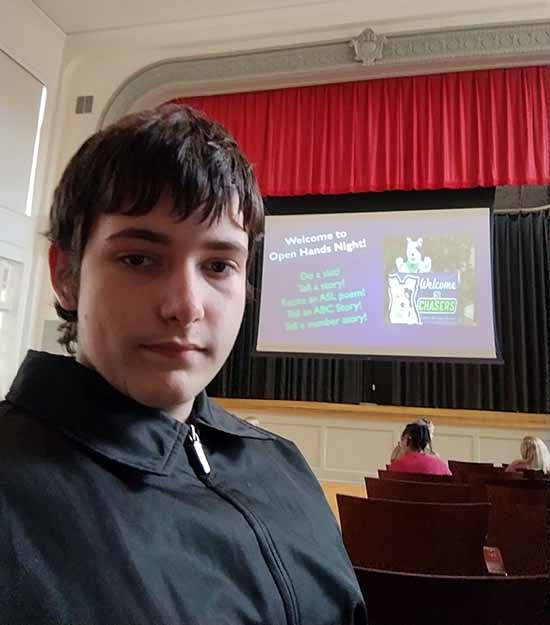Thanks to the flexibility of his homeschool program, 10th grader Aramis Lydic is a couple of years ahead of schedule academically. Among his signature achievements so far is something even adults frequently find difficult to accomplish: he’s connected with often-overlooked and sometimes-marginalized members of a community outside his own.
Aramis is an advanced student of American Sign Language (ASL). Though signing still fascinates him after years of study, he hopes that he’s doing more than simply gaining knowledge. He wants to focus on really getting to know people who are deaf and hard of hearing.

Photos courtesy of the family
Aramis Lydic attends an event promoting American Sign Language.
His mother, Sherry, recalled that—during his first ASL course—Aramis made an astute observation: “There’s a need for understanding and open communication.”
Sibling Influence
All of his four older siblings were homeschooled and have studied signing. His sister Octavia is in college, training to become an ASL interpreter.
Aramis has benefited from the experience of his siblings. Two of them attended the local community college, which inspired Aramis to enroll as soon as he entered high school.
In addition to ASL 201, Aramis is currently taking English and communications courses through dual enrollment at Spartanburg Community College in South Carolina. He is on track to earn an associate’s degree at the same time he finishes high school.
And though Aramis was familiar with ASL thanks to his siblings, he didn’t choose to study it until he encountered a deaf mom at his homeschool co-op, who communicated with her daughters in sign language.
“She saw that a few of us were interested and decided it would be good to do a small class,” Aramis recalled.
He followed up by enrolling in ASL 101 at the community college course in the 9th grade. Last summer he took ASL 102.
Personal Connections
Aramis noted that his most poignant insights into the world of the deaf and hard of hearing have come from attending informal events. He explained that the Deaf community organizes gatherings at restaurants and coffee shops, where anyone can come and converse.

Aramis delivers a video presentation in sign language.
“You can go even if you don’t know anybody,” said Aramis.
There are no rules regarding topics of conversation, but Aramis found that people tend to avoid controversial subjects.
“They talk a lot about food,” said Aramis.
Nevertheless, Aramis added that, by engaging in these events, he learned about the struggles that the Deaf community faces.
“It really changes your perspective,” he said. “When you’re in the language, you’re taught a lot about how the Deaf community is not treated correctly. You learn about how it’s hard for others.”
Aramis added that, thanks in large part to these events, he learned that sign language is very communicative and involves more than using your hands.
“It’s really all about the facial expressions,” he said. “When I do it for a long time, my eyes will get sore from watching the other people sign. That will probably go away as I sign more.”
He feels confident enough in the language to give presentations in ASL. He performed on stage at a nearby deaf school, telling stories with his hands. He’s also signed for his community college ASL club.
Learning Compassion
His mom pointed out that Aramis seems most pleased when he can use his knowledge of sign language to help people. For instance, at a local food bank where he volunteers, Aramis has been able to provide a more compassionate level of care to a deaf woman who comes regularly for assistance.
Aramis emphasized that his empathy stems from a growing understanding of the obstacles that the deaf and hard of hearing can encounter. He said he and his sister experienced an example of these unnecessary hindrances recently at a local public event.
He said that for about 20 minutes during the event, he and his sister signed to each other, which is a normal practice for them. In fact, he and his sister often communicate in ASL when they do video calls.
After the event, he recalled, a stranger who didn’t understand sign language or the Deaf community “approached me and said: ‘You shouldn’t be signing; you should be speaking.’ I didn’t say anything. I just left.”
Despite this uncomfortable experience, Aramis said he hopes to continue improving his ASL fluency. Among several career options, he’s considering training as an emergency medical technician—a role where being able to communicate with a broader range of people would be a definite advantage.
Regardless of what field he goes into, Aramis declared, “My ultimate plan is to stay in the Deaf community.”

